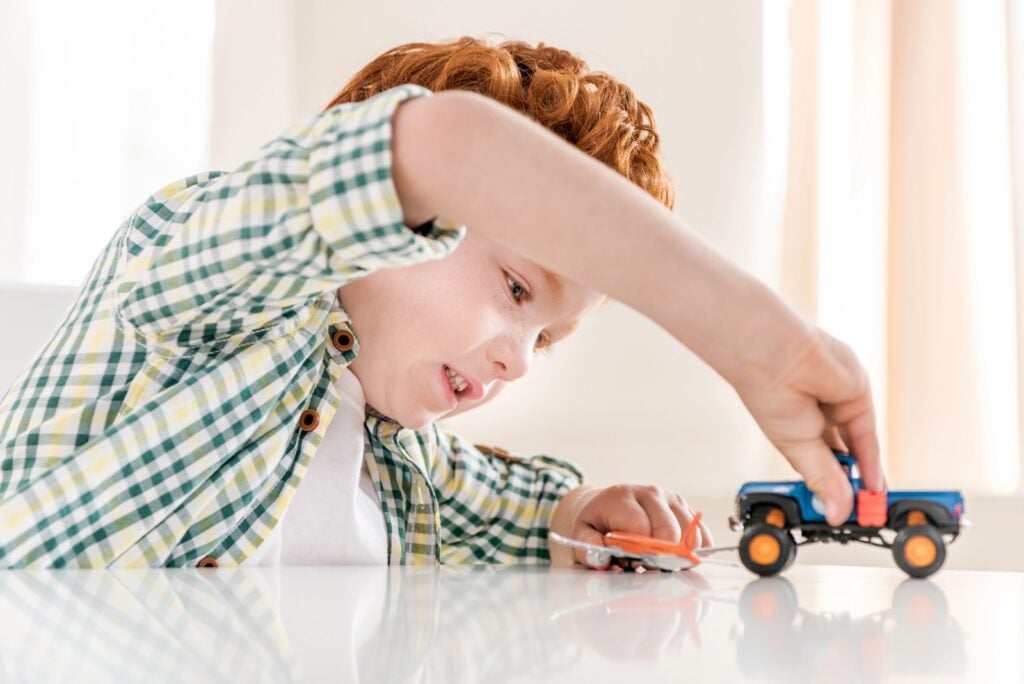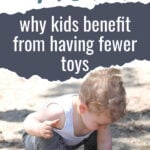Fewer Toys, More Fun
As grown ups, we’re often overwhelmed by the sheer number of choices we have to make in a day. Life is really no different for our children, on their own scale. So, if you’re asking yourself, “How many toys should a child have?” chances are, you are already onto something.
In truth, kids benefit from having fewer toys, and you can benefit from creating intentional (and minimal) play options for your child.

And while our children may be ecstatic about their glorious stash, the excitement is fleeting. Seriously, after opening a new toy, the average initial play time with it is fifteen minutes.
A Child’s Imagination Knows No Bounds
You’ve probably noticed that the toys with the most longevity offer kids more open-ended, creative play. And when you find the motivation to purge those overflowing toy bins and baskets, the kids seem much more at peace with playtime.
It’s why a stick, a piece of fabric, or an empty laundry basket can serve as any number of playthings. Your child uses their imagination to fill in all of the blanks.
While we’re on the subject of toys doing all of the entertaining, here’s a look at why it’s wise to limit the amount of battery operated toys your child has.
Present Moment Play
Have you ever really watched your children when they’re enveloped in the experience of play? Fully immersed in another world, one child might lean toward the concentrated silence while another gets super chatty. Either way, this is what play should be; interactive, hands-on, engaging, easy, immersive, fun.
On the other side of the coin, think about a moment that your child declared in frustration that they were “sooooo bored.”
Did they have access to activities?
Toys?
Crafts?
Electronics?
If the answer is yes (and you found yourself exclaiming back, “How can you be bored? What about all these toys?!”), there may be a very valid reason for their disengagement.
Studies show that the number of toys available to children directly correlates to how they play, how they learn, and even how they develop.
Play Is the Child’s Work
Famed educator Maria Montessori once said, “Play is the child’s work.” Parents are coming to understand this better; that play isn’t a frivolous way to get kids out of their hair. The toys we surround children with are their tools to achieve this “work” by aiding them in their play world – a world that frequently emulates the real world and gives children a chance to practice their real life skills.
As tools that allow children this playful practice help build confidence, socio-emotional development, independence, problem solving, and an overall understanding of their world, toys actually hold great importance.
So, surrounding kids with plenty of toys should be helpful?
In reality, it’s best to keep from having too many toys for several reasons.
- Children can focus better with fewer distractions.
- Kids also appreciate the toys they have and are more likely to care for them.
- There’s more mindfulness connected with this type of play and less mental fatigue, which helps create a more nurturing, calm learning experience.
- They are able to be more creative and flex their imaginations when given fewer toy choices. Studies back up Einstein’s claim that “the true sign of intelligence is not knowledge but imagination.”
- After studying more than 3,000 preschoolers, Professor of Educational Psychology at Oxford University, Kathy Sylva concluded that “when children have a large number of toys there seems to be a distraction element, and when children are distracted they do not learn or play well.” Her research shows that children with fewer toys whose parents spend more time reading, singing or playing with them surpass those from even more affluent backgrounds.
Studies Show Less is More
Two decades ago, a German project called, “Der Spielzeugfreie Kindergarten” (toy-free kindergarten or nursery) set out to see what would happen if toys were removed from kindergartens. Participating classrooms removed all toys for three months.
Teacher Gisela Marti shared, “In these three months we offer the children space and time to get to know themselves and because they are not being directed by teachers or toys, the children have to find new ways to master their day in their own individual way.”
The goal of the experiment was to nourish self-confidence, creativity, imagination, problem-solving skills, and socialization. The children were free to choose their own activities and their days were deliberately left unstructured to minimize rushing around.
On the first day, the children appeared confused and bored as they peered apprehensively around their big empty classroom. By the second day, the kids were playing with chairs and blankets, making forts with blankets and weighing them down with shoes. In the following days, they began to excitedly run and chat around the room. By the end of the third month, they engaged in wildly imaginative play. They also showed improved concentration and communication skills.
How to Cut Back on Available Toys
If this compels you to change things up in your home, here are some ways to cut back on the mass of unused toys (without coming off as a total fun hater):
Involve the Kids (Maybe)
Depending on your child’s age and maturity level, you may want to go through the purging experience alone, but if you think they can understand the process, by all means get them involved.
When children are a part of the cutting back and donating, they obtain a deeper understanding of what they truly love, criteria that makes a toy fun or important to keep, and the empathy connected with donating to others who may not have much. They’ll also gain an appreciation for the toys they’ve decided to keep.
Try the Konmarie Method
The decluttering philosophy of Marie Kondo can be summed up by asking yourself one question: “does this spark joy?” If your child is helping in the purge, discuss what this means and have them hold each toy to assess their joy.
Oh, and don’t forget that they can thank each item they donate for the purpose it has served. Kids are actually better at this than adults; I think we’re sometimes too jaded to talk to inanimate objects.
Be Flexible
Whether your kids are involved or not, start by placing a box (or two…or three) of your children’s least favorite toys in a storage area of your home (out of sight) for a month or two.
If your child asks for a particular toy during that time, it’s still an important play tool and can be retrieved. Odds are, however, out of sight will mean out of mind and those toys can find a new home. And be honest if you’ve done away with a toy that’s broken or outgrown if you’re asked about it; this isn’t about deceiving our children.
Discuss Non-Toy Gift Ideas
When a birthday is impending, discuss what your child truly wants out of the day; is it the stuff or a day to celebrate them with friends and family? If there’s one big toy they’ve been pining for, you can offer the idea to grandparents or get it yourself, but suggest no gifts or a donation for others to bring instead of a gift.
Some children are proud and glad to use their birthday party as a chance to collect supplies for an animal shelter or money for another worthy cause that means something to them.
Offer More Open-Ended Toys
Offer gift ideas to family and friends that you can feel good about having in your home. Wooden puzzles, play food and building blocks, occupational and “cleaning” kits, dress-up costumes, magnetic building tools, and craft supplies.
These types of toys offer more imaginative possibilities and endless opportunities for pretend playtime. No battery toys contribute to early childhood education – boosting critical thinking and problem-solving skills. They also foster a sense of satisfaction in doing things “all by myself,” as the independent toddler likes to announce.
Have a Toy-Free Day
Don’t just declare it a “don’t play with toys” day and leave it at that. Brainstorm ideas with your child of what to do instead of depending on toys all the time.
If it’s a nice day, head outside together or go for a nature walk. If it’s a yucky day outside, you can still play in the rain, maybe you won’t spend as much time outside. So build pillow and blanket forts, reuse cardboard boxes to direct play, bake cookies, and read fun books.
Or plan a day out at a kid-friendly museum or soft play spot. Not only does this create great memories, but will most likely give your child a renewed interest in their toys.
Start a Simple Toy Rotation
This is my favorite tip, whether you have a few or a lot of toys. When we rotate toys and store the ones that still have value to us it’s like what Christmas should be. We can often get a full day (and beyond) of completely independent, self-directed playtime.
After purging, watch how play has changed in your house. Give every toy a home of its own to help contain the clutter and enjoy observing the fun storylines and amazing buildings that unfold before you, all courtesy of your own child’s incredible imagination.
Spend More Time Outside
Nature offers countless toys that are generally impermanent. Make a point to get outside daily with your child and look for ways to play with what they find organically.
Outdoor play is essential for a child’s mental health, school performance, physical wellbeing, their microbiome, their vestibular system, and so much more. It also helps you foster a lower-tech parenting approach.
Here are some fun activities to help your child enjoy the great outdoors:
How to Make Sun Print Art
Owling with Kids
Stargazing with Kids
Backyard Bug Count Activity
Fairy Garden Ideas for a Magical Backyard

